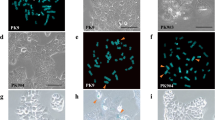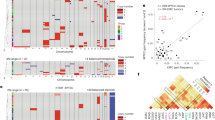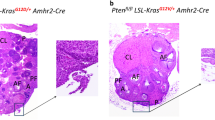Abstract
Multiple distinct regions of chromosome 6 are frequently affected by losses of heterozygosity in primary human ovarian carcinomas. We introduced a normal human chromosome 6 into HEY and SKOV-3 ovarian carcinoma cell lines using microcell-mediated chromosome transfer techniques to further investigate the role of this chromosome in ovarian tumorigenesis. The exogenous chromosome was stably propagated in the recipient cells based on fluorescence in situ hybridization (FISH) analyses with a chromosome 6 painting probe. The tumorigenicity of HEY and SKOV-3 cells was completely suppressed after transfer of chromosome 6, but not after transfer of a chromosome 11q13-qter fragment used as control. Using 46 polymorphic microsatellite markers, the region bounded by D6S1649 and D6S1564 was found to be commonly deleted in HEY: chromosome 6 tumorigenic revertant clones. The boundaries of the commonly deleted region could be further narrowed down to a 2 cM (based on the Whitehead genetic map) or 0.36 megabase (based on gdb mapping data) region between D6S1637 and D6S1564 after transferring the exogenous chromosome from revertants into mouse L cells and performing allelic deletion mapping studies against this mouse background. We conclude that this region contains a tumor suppressor gene important for the control of ovarian tumor development.
This is a preview of subscription content, access via your institution
Access options
Subscribe to this journal
Receive 50 print issues and online access
$259.00 per year
only $5.18 per issue
Buy this article
- Purchase on Springer Link
- Instant access to full article PDF
Prices may be subject to local taxes which are calculated during checkout



Similar content being viewed by others
References
Abdollahi A, Roberts D, Godwin AK, Schultz DC, Sonoda G, Testa JR and Hamilton TC. . 1997 Oncogene 14: 1973–1979.
Banga SS, Kim S-H, Hubbard K, Dasgupta T, Jha KK, Patsalis P, Hauptschein R, Gamberi B, Dalla-Favera R, Kraemer P and Ozer HL. . 1997 Oncogene 14: 313–321.
Buick RN, Pullano R and Trent JM. . 1985 Cancer Res. 45: 3668–3676.
Cliby W, Ritland S, Hartmann L, Dodson M, Halling KC, Keeney G, Podratz KC and Jenkins RB. . 1993 Cancer Res. 53: 2393–2398.
Cooke IE, Shelling AN, Le Meuth VG, Charnock ML and Ganesan TS. . 1996 Genes, Chromosomes & Cancer 15: 223–233.
Cooney KA, Wetzel JC, Consolino CM and Wojno KJ. . 1996 Cancer Res. 56: 4150–4153.
Deger RB, Faruqi SA and Noumoff JS. . 1997 Cancer Genet. Cytogenet. 96: 166–173.
Devilee P, van Vliet M, van Sloun P, Kuipers Dijkshoorn N, Hermans J, Pearson PL and Cornelisse CJ. . 1991 Oncogene 6: 1705–1711.
Dib C, Faure S, Fizames C, Samson D, Drouot N, Vignal A, Millasseau P, Marc S, Hazen J, Seboun E, Lathrop M, Gyapay G, Morissette J and Weissenbach J. . 1996 Nature 380: 152–154.
Ehlen T and Dubeau L. . 1990 Oncogene 5: 219–223.
Foulkes WD, Ragoussis J, Stamp GW, Allan GJ and Trowsdale J. . 1993 Br. J. Cancer 67: 551–559.
Gerard B, Cave H, Guidal C, Dastugue N, Vilmer E and Grandchamp B. . 1997 Leukemia 11: 228–232.
Hudson TJ, Stein LD, Gerety SS, Ma J, Castle AB, Silva J, Slonim DK, Baptista R, Kruglyak L and Xu SH. . 1995 Science 270: 1945–1954.
Lee JH, Kavanagh JJ, Wildrick DM, Wharton JT and Blick M. . 1990 Cancer Res. 50: 2724–2728.
Lugo TG, Handelin B, Killary AM, Housman DE and Fournier RE. . 1987 Molec. Cell. Biol. 7: 2814–2820.
Menasce LP, Orphanos V, Santibanez-Koref M, Boyle JM and Harrison CJ. . 1994 Genes, Chromosomes & Cancer 10: 286–288.
Merlo A, Gabrielson E, Mabry M, Vollmer R, Baylin SB and Sidransky D. . 1994 Cancer Res. 54: 2322–2326.
Negrini M, Sabbioni S, Possati L, Rattan S, Corallini A, Barbanti-Brodano G and Croce CM. . 1994 Cancer Res. 54: 1331–1336.
Orphanos V, McGown G, Hey Y, Thorncroft M, Santibanez-Koref M, Russell SE, Hickey I, Atkinson RJ and Boyle JM. . 1995 Br. J. Cncer 71: 666–669.
Orphanos V, Santibanez-Koref M, McGown G, Hey Y, Rackstraw C and Boyle JM. . 1994 Genomics 20: 301–304.
Saha V, Lillington DM, Shelling AN, Chaplin T, Yaspo ML, Ganesan TS and Young BD. . 1995 Genes, Chromosomes & Cancer 14: 220–222.
Saito S, Saito H, Koi S, Sagae S, Kudo R, Saito J, Noda K and Nakamura Y. . 1992 Cancer Res. 52: 5815–5817.
Saito S, Sirahama S, Matsushima M, Suzuki M, Sagae S, Kudo R, Saito J, Noda K and Nakamura Y. . 1996 Cancer Res. 56: 5586–5589.
Sandhu AK, Kaur GP, Reddy DE, Rane NS and Athwal RS. . 1996 Oncogene 12: 247–252.
Sheer D, Sheppard DM, Gorman PA, Ward B, Whelan RD and Hill BT. . 1987 Cancer Genet. Cytogenet. 26: 339–349.
Sheng ZM, Marchetti A, Buttitta F, Champeme MH, Campani D, Bistocchi M, Lidereau R and Callahan R. . 1996 Br. J. Cancer 73: 144–147.
Tibiletti MG, Bernasconi B, Furlan D, Riva C, Trubia M, Buraggi G, Franchi M, Bolis P, Mariani A, Frigerio L, Capella C and Taramelli R. . 1996 Cancer Res. 56: 4493–4498.
Tibiletti MG, Bernasconi B, Taborelli M, Furlan D, Fabbri A, Franchi M, Taramelli R, Trubia M and Capella C. . 1997 Br. J. Cancer 75: 1831–1835.
Tibiletti MG, Trubia M, Ponti E, Sessa L, Acquati F, Furlan D, Bernasconi B, Fichera M, Mihalich A, Ziegler A, Volz A, Facco C, Riva C, Cremonesi L, Ferrari M and Taramelli R. . 1998 Oncogene 16: 1639–1642.
Trent JM and Salmon SE. . 1981 Cancer Genet. Cytogenet 3: 279–291.
Trent JM, Stanbridge EJ, McBride HL, Meese EU, Casey G, Araujo DE, Witkowski CM and Nagle RB. . 1990 Science 247: 568–571.
Varrault A, Ciani E, Apiou F, Bilanges B, Hoffmann A, Pantaloni C, Bockaert J, Spengler D and Journot L. . 1998 Proc. Natl. Acad. Sci. USA 95: 8835–8840.
Volz A, Boyle JM, Cann HM, Cottingham RW, Orr HT and Ziegler A. . 1994 Genomics 21: 464–472.
Wake N, Hreshchyshyn MM, Piver SM, Matsui S and Sandberg AA. . 1980 Cancer Res. 40: 4512–4518.
Walker GJ, Palmer JM, Walters MK, Nancarrow DJ, Parsons PG and Hayward NK. . 1994 Int. J. Cancer 58: 203–206.
Wan M, Cofer KF and Dubeau L. . 1996 Br. J. Cancer 73: 1398–1400.
Wan M, Zweizig S, D'Ablaing G, Zheng J, Velicescu M and Dubeau L. . 1994 Int. J. Oncol. 5: 1043–1048.
Welch DR, Chen P, Miele ME, McGary CT, Bower JM, Stanbridge EJ and Weissman BE. . 1994 Oncogene 9: 255–262.
Whang-Peng J, Knutsen T, Douglass EC, Chu E, Ozols RF, Hogan WM and Young RC. . 1984 Cancer Genet. Cytogenet. 11: 91–106.
Acknowledgements
The authors would like to thank Dr Eric Stanbridge for providing us with the chromosome 6 mouse:human microcell hybrid, Dr Jane Fountain for helpful comments and advice throughout the course of this work, and Michelle Luo for help in preparing the manuscript. This study was supported by grant RO1 CA51167 from the US National Cancer Institute.
Author information
Authors and Affiliations
Rights and permissions
About this article
Cite this article
Wan, M., Sun, T., Vyas, R. et al. Suppression of tumorigenicity in human ovarian cancer cell lines is controlled by a 2 cM fragment in chromosomal region 6q24-q25. Oncogene 18, 1545–1551 (1999). https://doi.org/10.1038/sj.onc.1202476
Received:
Revised:
Accepted:
Published:
Issue Date:
DOI: https://doi.org/10.1038/sj.onc.1202476
Keywords
This article is cited by
-
Allelic loss of 6q25-27, the PARKIN tumor suppressor gene locus, in cervical carcinoma
Medical Oncology (2011)
-
Parkin Gene Alterations in Ovarian Carcinoma from Northern Indian Population
Pathology & Oncology Research (2011)
-
Specific chromosomal imbalances as detected by array CGH in ependymomas in association with tumor location, histological subtype and grade
Journal of Neuro-Oncology (2010)
-
UTRN on chromosome 6q24 is mutated in multiple tumors
Oncogene (2007)
-
SASH1: a candidate tumor suppressor gene on chromosome 6q24.3 is downregulated in breast cancer
Oncogene (2003)



